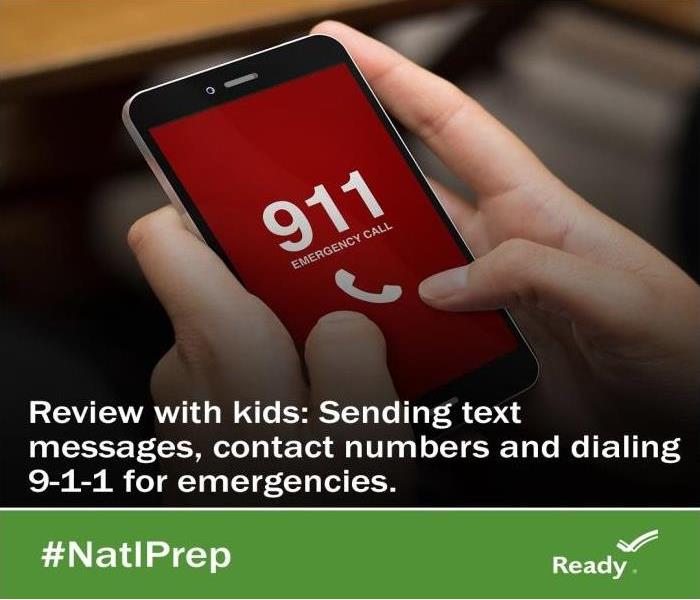Do your Children Know What To Do in the Event of a Disaster?
9/20/2021 (Permalink)
National Preparedness Month September 19-25: Teach Youth About Preparedness
Week Four of National Preparedness Month focuses on Youth.
Many families are not together during an emergency, its important that your children and young adults know what to do during different types of emergencies.
Talk to your kids about preparing for emergencies and what to do in case you are separated. Reassure them by providing information about how they can get involved.
How Can You Prepare Your Family?
Being prepared for disasters starts at home. Everyone can be part of helping to prepare for emergencies. Young children and teens alike can be a part of the process. As a parent, guardian, or other family member, you have an important role to play when it comes to protecting the children in your life and helping them be prepared in case disaster strikes.
We will touch on how to build your family emergency plan, how you can help children cope if they’ve experienced a disaster, and tips to help your children be ready when disaster strikes. With these tools, both kids and their families can be prepared whether they’re at home, school, or anywhere else.
How to Build and Emergency Plan
Some disasters strike without any warning, and family members may not all be in the same place. How will you get in touch with each other? Where will you meet? How will you get out of your house in case of a fire? What if your neighborhood is being evacuated? It's important to make a plan, now, so that you will know what to do, how to find each other, and how to communicate in an emergency.
How to Build a Kit
Being prepared for an emergency isn't just about staying safe during a storm or a disaster. It's also about how to stay comfortable, clean, fed, and healthy afterwards—when a storm or disaster may have knocked out electricity.
If you lost power, how would you eat? The refrigerator wouldn’t keep your food cold. The microwave couldn’t warm things up. You might not get clean water out of your faucets. How would you find out if it was safe to play outside? Not from your TV or computer!
If power is out, you also might not be able to go to the store or the bank. Being prepared means having your own food, water, cash, and other supplies to last for at least three days, and possibly longer if you are in a remote or hard-to-reach area.
Check out our blog on How Build a Basic Disaster Emergency Supply Kit
Helping Children Cope
Disasters can leave children and teens feeling frightened, confused and insecure. Their responses can be quite varied. It's important to not only recognize these reactions, but also help children cope with their emotions.
Encourage dialogue and answer questions
Listen to your kids. Ask them about their feelings and validate their concerns. When they ask questions, give just the amount of information you feel your child needs.
Make time for them and find support
Help kids understand that they are safe and secure by talking, playing, and doing other family activities with them. Build support networks with friends, family, and community organizations to help you cope, which can also help your children cope.
Keep to a routine
Help your children feel as if they still have a sense of structure, which can make them feel more relaxed. When schools and childcare open again, help children return to normal activities like going to class, sports, and play groups.
Risk Factors
For many kids, reactions to disasters are short-term. But some children can be at risk for more long-term psychological distress. Three risk factors for this longer-lasting response are:
- Direct exposure to the disaster such as being evacuated, observing injuries of others, or experiencing injury.
- Loss/grief relating to the death or serious injury of family or friends.
- Ongoing stress from secondary effects, such as temporary housing, loss of social networks, loss of personal property, or parent's unemployment.
Stay involved with your children and young adults. Our blogs for the month of September all focus on emergency preparedness.






 24/7 Emergency Service
24/7 Emergency Service
